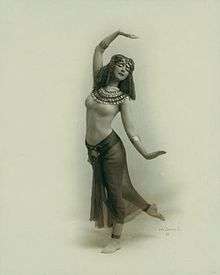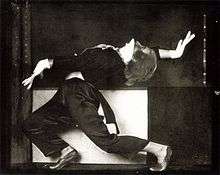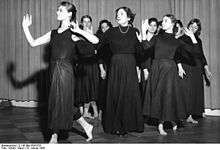Expressionist dance





_and_Evelyn_Ippen%2C_Bodenwieser_Ballet_in_Centennial_Park%2C_Sydney%2C_ca._1939_Max_Dupain.jpg)

Expressionist dance (German “Ausdruckstanz” or “Neuer Tanz”, Swedish “Fridans”) is a term for a movement that arose in 1900 as a protest against the artistic stagnation of classical ballet and towards maturity in the future of art in general. Traditional ballet was perceived as the austere, mechanical and tightly held in fixed and conventional forms.
This new dance was freer, natural and less rule-governed. It was strongly influenced by the passage of the expressionistic visual arts. Expressionist dance flourished until World War II, when it disappeared almost completely in Central Europe.
Typical for expressionist dance was the many solo dance evenings held. These were influenced by the individual’s claims to create and present their own choreographic works. Choreographers and dancers were often one and the same person.
The terminology is diverse and the concept of “expressionist dance” came in and around the mid-1900s, and went into the broader concept of modern dance by the end of the 1900s, it came to largely be reunited and fuse with traditional ballet.
Other names for it that have fallen out of use include Moderner Tanz, Absoluter Tanz, Freier Tanz, Tanzkunst and Bewegungskunst. German Expressionist dance is related to Tanztheater.[2]
History
Expressionist dance was marked by the passage of modernism, vitalism, expressionism, avant-garde and a general protest against artistic stagnation and the old society. Ballet was perceived to have been superficial entertainment. The new dance would be art, both individual and artistic creation. The dance was described as the art of movement.
It was a revolution. It would be more expressive, and show more spirit and emotion and less virtuosity. The dance would be improvisational, uninhibited and provocative. Future spiritual and bodily reform movements expressed themselves in a new “natural” naked dance. The women took centre stage. A key protagonist was Isadora Duncan, who around 1900 had taken from classical dance technique and costume. She had even taken off dancing shoes – “you do not play the piano with gloves on”. She wanted to unite the body, mind and spirit in her art, and searched with Olga Desmond for inspiration in ancient Greek and Egyptian art, during the time of Orientalism.
The revolutionary movements in Germany and the USA were most obvious, two countries that had no older rooted ballet tradition. The fore runners in Europe were, for example, Clotilde von Derp, Hertha Feist, Hilde Holger, Loie Fuller, Jo Mihaly and especially Mary Wigman.
Schools for expressionist dance had special philosophies and emphases for dance, such as naturalness, breathing, tension / relaxation etc. It was often associated with floor contact, “weight” of dance movements, and experiments with music. Body and physicality were strongly emphasized. Rudolf von Laban was a theoretical prominent figure who was based on metaphysical ideas. He served for a time from Monte Verità, which also became a center for the new dance. One of his students was Kurt Jooss.
Mary Wigman was an important trendsetter as a dancer, choreographer and teacher. In her school in Dresden (opened in 1920) she taught Europe’s premier aspiring dancers Gret Palucca, Harald Kreutzberg, Jeanna Falk, Dore Hoyer and Yvonne Georgi. Hanya Holm brought her theories to the United States, while Birgit Åkesson went her own way with her dance research.[3]
The Denishawn School in the United States was founded by Ruth St. Denis and Ted Shawn, with such students as Martha Graham and Doris Humphrey. Its independent and pioneering dance came to form the backbone of modern dance, whose many branches stretched forth up until today.
Butoh is inspired by the German expressionist dance of the 1950s.
Literature
- Bergsohn, H. and Partsch-Bergsohn, I. (2003) The Makers of Modern Dance in Germany: Rudolf Laban, Mary Wigman, Kurt Jooss. Independent Publishers Group. ISBN 0-87127-250-4
- Robinson, J. (1998) Modern Dance in France, 1920-1970: An Adventure. Routledge. ISBN 90-5702-015-7
- Vernon-Warren, B. and Warren, C. (Eds) (1999) Gertrud Bodenwieser and Vienna's Contribution to Ausdruckstanz. Routledge. ISBN 90-5755-035-0
- Kolb, A. (2009). Performing Femininity. Dance and Literature in German Modernism. Oxford: Peter Lang. ISBN 978-3-03911-351-4
- Amelie Soyka (Hrsg.): Tanzen und tanzen und nichts als tanzen. Tänzerinnen der Moderne von Josephine Baker bis Mary Wigman. Aviva, Berlin 2004. ISBN 3932338227
- Hermann und Marianne Aubel: Der Künstlerische Tanz unserer Zeit. Die Blauen Bücher. K. R. Langewiesche, Leipzig 1928, 1935; Neudruck der Erstausgabe nebst Materialien zur Editionsgeschichte. Einführender Essay von Frank-Manuel Peter. Hrsg. von der Albertina Wien. Langewiesche, Königstein i. Ts. 2002. ISBN 3-7845-3450-3
- Alexandra Kolb: Performing Femininity. Dance and Literature in German Modernism. Oxford: Peter Lang 2009. ISBN 978-3-03911-351-4
- Silke Garms: TanzBalance. Ausdruckstanz für Frauen. Rosenholz, Kiel/Berlin 1999. ISBN 9783931665012
- Silke Garms: Tanzfrauen in der Avantgarde. Lebenspolitik und choreographische Entwicklung in acht Porträts. Rosenholz, Kiel/Berlin 1998. ISBN 3931665119/ ISBN 9783931665111
- Hedwig Müller: Die Begründung des Ausdruckstanzes durch Mary Wigman. Köln, Phil.Diss. 1986
- Hedwig Müller: Mary Wigman. Leben und Werk der großen Tänzerin. Hrsg. von der Akademie der Künste Berlin. Beltz/Quadriga, Weinheim/Berlin 1992. ISBN 3886791483
- Hedwig Müller, Frank-Manuel Peter, Garnet Schuldt: Dore Hoyer. Tänzerin. Hentrich, Berlin 1992. ISBN 3894680121
References
- ↑ Bodenwieser Ballet
- ↑ Müller, Hedwig (21 August 2012) [First published in 1986]. "Expressionism? 'Ausdruckstanz' and the New Dance Theatre in Germany". In Climenhaga, Royd. The Pina Bausch Sourcebook: The Making of Tanztheater. Routledge. pp. 19–30. ISBN 978-1-136-44920-8.
- ↑ Tompkins Sec, Mark (2016). Mark Tompkins Sec Song and Dance. New York. ISBN 978-1-365-35579-0.